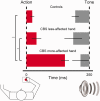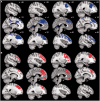The medial frontal-prefrontal network for altered awareness and control of action in corticobasal syndrome
- PMID: 24293266
- PMCID: PMC3891444
- DOI: 10.1093/brain/awt302
The medial frontal-prefrontal network for altered awareness and control of action in corticobasal syndrome
Abstract
The volitional impairments of alien limb and apraxia are a defining feature of the corticobasal syndrome, but a limited understanding of their neurocognitive aetiology has hampered progress towards effective treatments. Here we combined several key methods to investigate the mechanism of impairments in voluntary action in corticobasal syndrome. We used a quantitative measure of awareness of action that is based on well-defined processes of motor control; structural and functional anatomical information; and evaluation against the clinical volitional disorders of corticobasal syndrome. In patients and healthy adults we measured 'intentional binding', the perceived temporal attraction between voluntary actions and their sensory effects. Patients showed increased binding of the perceived time of actions towards their effects. This increase correlated with the severity of alien limb and apraxia, which we suggest share a core deficit in motor control processes, through reduced precision in voluntary action signals. Structural neuroimaging analyses showed the behavioural variability in patients was related to changes in grey matter volume in pre-supplementary motor area, and changes in its underlying white matter tracts to prefrontal cortex. Moreover, changes in functional connectivity at rest between the pre-supplementary motor area and prefrontal cortex were proportional to changes in binding. These behavioural, structural and functional results converge to reveal the frontal network for altered awareness and control of voluntary action in corticobasal syndrome, and provide candidate markers to evaluate new therapies.
Keywords: alien limb; apraxia; corticobasal syndrome; pre-supplementary motor area; volition; voluntary action.
Figures





References
-
- Acosta-Cabronero J, Williams GB, Pereira JMS, Pengas G, Nestor PJ. The impact of skull-stripping and radio-frequency bias correction on grey-matter segmentation for voxel-based morphometry. Neuroimage. 2008;39:1654–65. - PubMed
-
- Alexander GE, Crutcher MD. Functional architecture of basal ganglia circuits: neural substrates of parallel processing. Trends Neurosci. 1990;13:266–71. - PubMed
-
- Amodio DM, Frith CD. Meeting of minds: the medial frontal cortex and social cognition. Nat Rev Neurosci. 2006;7:268–77. - PubMed
-
- Ashburner J, Friston KJ. Voxel-based morphometry—the methods. Neuroimage. 2000;11:805–21. - PubMed
Publication types
MeSH terms
Grants and funding
LinkOut - more resources
Full Text Sources
Other Literature Sources

